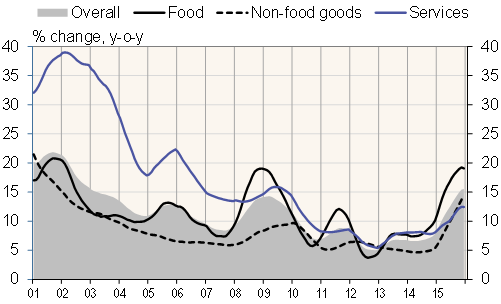BOFIT Weekly Review 2/2016
Russian inflation surged to heights last year
The on-month rise in consumer prices in December, as in November, outpaced the last significant rise in November-December 2010 – not counting the record inflation spike at the end of 2014, the biggest since the 1998 financial crisis. Leading the high inflation numbers was the continued increase in food prices, but the increase for non-food goods also went on. The ruble’s slide, which worsened dramatically in December as the ruble lost 10 % of its external value, has been a crucial factor in fuelling inflation. Ruble’s slide episodes readily create expectations in the import trade chain and among households of further exchange rate slide and continuing high inflation. Russian import restrictions on Turkish food items likely added to inflation pressures somewhat.
December 2015 consumer prices were up 12.9 % y-o-y (11.4 % at the end of 2014). Due to the inflation burst a year ago, for 2015 overall inflation was up on average 15.5 % over 2014. The high inflation tells about the extent of the loss of household purchasing power and reduced consumption. The annual average indicates that consumer prices rose faster than at any time since 2002. Episodes of high food price inflation as seen in 2015 were last experienced in 2008 and 2001. No similar episode of run-away non-food goods price inflation has been seen since 2001. The last similar rise in prices of services was in the early months of 2010.
Consumer prices, change of 12-month average

Source: Rosstat.